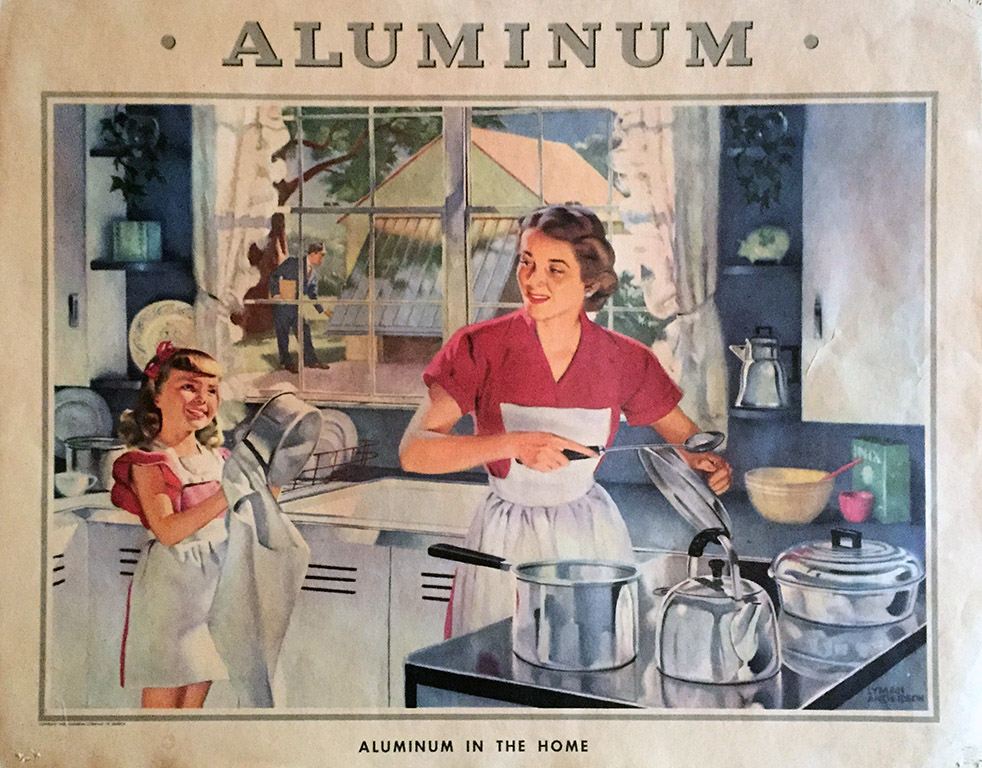A boomtown boomer in the North Country
My family came to the North Country as “boomtown” transplants in 1957. Work was just being finished on the Seaway and the Moses-Saunders Power Dam. The North Country was awash with youngish newcomers like my dad, WWII-era veterans drawn by the boom centered in Massena. He sold business machines for Remington Rand–typewriters and mechanical adding machines and such pre-computer tech–to the new and expanding companies drawn north by cheap hydropower and the opening of shipping into the industrial heartland of the U.S. and Canada. My mom was also typical of the newcomers, a mother of young children who cut her teeth on defense plant work and continued to juggle jobs inside and outside the home.

“Aluminum in the Home,” industrial poster. Artist: Lyman Anderson. Aluminum Company of America, 1948
As with most transplants, the prior history of the region was invisible to me. I had no notion of the trauma occasioned by the relocation of 6,500 residents, the drowning of six villages and 63 square miles of land under the swelling Lake St. Lawrence. I was five, and the coolest thing I had ever seen was a two-and-a-half story Queen Anne-style house being moved down the road on an enormous flatbed.
I was starting my education in a brand-new central school building built during the International Geophysical Year at the dawn of the Space Race. Sputnik was beeping overhead. Everything was about the future, and the future it seemed would be built from aluminum. It would be made in the North Country.
And my future was made here, still is. Just not the future we all envisioned in the 1950s. What we called the industrial heartland then, we call the Rust Belt now. Massena’s more than century-long run as a manufacturing town will be down to a couple hundred jobs by next year. Which leaves me to wonder, if the future will not be made from aluminum, what will it be made from? The floor is open to suggestions.
Tags: listeningpost








As someone who lives close enough to the Catskills to have read and seen much about the drowning of the Esopus Valley to construct the Ashokan Reservoir, I was intrigued to read your reference to the six drowned villages and wondered whether this was something similar or whether it was a meteorological accident. So I looked up the story online. Hm. I’d never heard about this before; thanks for the reference. As for Massena, I pray that it bounds back from this blow and finds new life.
Other areas with surplus hydro power have been selected as sites for big data centers – they are the cloud computing services everyone uses these days. Think Google, Amazon, etc. Very large power hungry plants that generate a lot of heat, requiring cooling systems. The Columbia River dams have several data centers. The TVA dam system has some. These do not offer anything like the same number of jobs, but there are jobs involved, and they do pay taxes.
I recall a childhood visit to see the dam and the locks in Messena – late 1950s or early 1960s sometime. I was awed. Maybe it is time I visited again.
After visiting here a few times over the years my wife and I decided to retire here (winters and all). It is great place to retire if you are healthy and active. Retirees bring in money and jobs (health care and other services) without all the mess of manufacturing. I have long believed that is the future of the North Country.